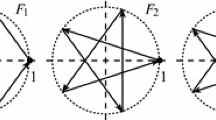Abstract
A disc in \({{\mathbb R}^2}\) is called self-affine if it can be dissected into m ≥ 2 affine images of itself. We show that every self-affine convex disc D is a polygon. As a corollary, it turns out that D must be a triangle, a quadrangle or a pentagon.
Similar content being viewed by others
References
Bernheim B., Motzkin T.: A criterion for divisibility of n-gons into k-gons. Comment. Math. Helv. 22, 93–102 (1949)
Croft H.T., Falconer K.J., Guy R.K.: Unsolved problems in geometry, Problem Books in Mathematics. Unsolved Problems in Intuitive Mathematics, II. Springer-Verlag, New York (1991)
Falconer K.: Fractal geometry. Mathematical foundations and applications. John Wiley & Sons, Chichester (1997)
Hertel, E.: Zur Affingeometrie konvexer Polygone. Jenaer Schriften zur Mathematik und Informatik, Math/Inf/00/22 (2000) (preprint)
Tölke, J. Wills, J.M. (eds): Contributions to geometry. Proceedings of the Geometry-Symposium held in Siegen, June 28 to July 1, 1978. Birkhäuser Verlag, Basel (1979)
Author information
Authors and Affiliations
Corresponding author
Additional information
Dedicated to Prof. Dr. Eike Hertel on the occasion of his 70th birthday.
This research was supported by DFG grant RI 1087/3.
Rights and permissions
About this article
Cite this article
Richter, C. Self-affine convex discs are polygons. Beitr Algebra Geom 53, 219–224 (2012). https://doi.org/10.1007/s13366-011-0044-8
Received:
Accepted:
Published:
Issue Date:
DOI: https://doi.org/10.1007/s13366-011-0044-8



